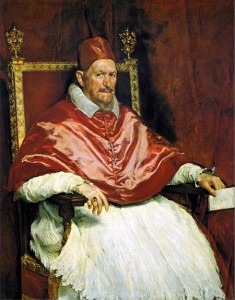
Velázquez: Pope Innocent (1650)
Velázquez was traveling to Italy in 1650 and painted the picture of the pope after he had already painted other people from the papal court with great success. The portrait has never been outside the pope’s family and during much of the 17th and 18th century was regarded as a hidden masterpiece. It is considered Velázquez’ great portrait and, in fact, one of the finest portraits every produced. It captures the essence of a vibrant powerful man and when Innocent X saw the finished work, he is supposed to have said “Troppo vero!” (“All too true!”).
In the 1950s, Francis Bacon took on the Velázquez picture as the basis for a series of more than 45 variants on the original. He was fascinated with the color scheme and used the elements of the background curtains, his distinctive over-cape, and the long white robe in his own work. Bacon said that he portrayed the pope again and again “an excuse to use these colours, and you can’t give ordinary clothes that purple colour without getting into a sort of false fauve manner.”
Bacon takes Velázquez’ rather cautiously self-satisfied pope and turns him into a ghoulish figure, mouth open in a never-ending scream, seeming to grip his throne as another kind of physical representation of the scream. Yet, his face recedes into the background, overpainted by the drapes and hidden in the dark colors.

Bacon: Study after Velázquez’s Portrait of Pope Innocent X (1953)
Turnage: 3 Screaming Popes (City of Birmingham Symphony Orchestra; Simon Rattle, cond.)
The work starts out as though it were directly putting Bacon’s work into sound: edgy shrieks, drawn-out climaxes, quick silences. Then, as you listen closer, you start to hear the Spanish elements in the music and hear how Turnage puts his own distortion field on something might be otherwise familiar.
Turnage, who was awarded a CBE in the 2015 Queen’s Birthday honours, is one of the most widely-performed composers of today and in this work we can understand how the strong imagery of Bacon were so influential in creating an equally strong modern work.
